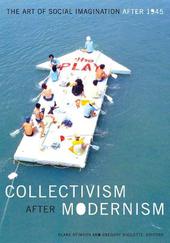
|
Collectivism after Modernism: The Art of Social Imagination after 1945
Paperback / softback
Main Details
| Title |
Collectivism after Modernism: The Art of Social Imagination after 1945
|
| Authors and Contributors |
Edited by Blake Stimson
|
|
Edited by Gregory Sholette
|
| Physical Properties |
| Format:Paperback / softback | | Pages:304 | | Dimensions(mm): Height 254,Width 178 |
|
| Category/Genre | Theory of art
Art and design styles - from c 1900 to now |
|---|
| ISBN/Barcode |
9780816644629
|
| Classifications | Dewey:709.04 |
|---|
| Audience | | Professional & Vocational | |
|---|
|
Publishing Details |
| Publisher |
University of Minnesota Press
|
| Imprint |
University of Minnesota Press
|
| Publication Date |
20 February 2007 |
| Publication Country |
United States
|
Description
The desire to speak in a collective voice has long fueled social imagination and artistic production. Organized around a series of case studies spanning the globe from Europe, Japan, and the United States to Africa, Cuba, and Mexico, this book covers such renowned collectives as the Guerrilla Girls and the Yes Men, as well as lesser-known groups. Contributors explore the ways in which collectives function within cultural norms, social conventions, and corporate or state-sanctioned art. They examine the impact of new technologies on artistic practice, the emergence of networked group identity, and the common characteristic of collective production to blur the typical separations between artists, activists, service workers, and communities in need.
Reviews" Contrary to some strains of popular belief, collectivism is artmaking not only with" many but for" many. For the historical avant-garde- like the Dadaists or the Constructivists- it embodied the revolutionary power of communal force, one that would, in the future, alleviate the alienation of capitalist individualism. For artists during the Cold War, it meant sharing an experience beyond that of mass consumption, at a time when the communal utopias of the recent past were, at best, dismissed as nai ve phantasmagorias or, at worst, seen as having materialized in the form of totalitarian regimes. And a few years ago, fueled by curatorial interest, a trend emerged of group art practice as a kind of clubby tribalism. To understand the various forms of postwar collectivism as historically determined phenomena and to articulate the possibilities for contemporary collectivist art production is the aim of "Collectivism after Modernism. "The essays assembled in this anthology argue that to make truly collective art means to reconsider the relation between art and public; examples from the Situationist International and Group Material to Paper Tiger Television and the Congolese collective Le Groupe Amos make the point. To construct an art of shared experience means to go beyond projecting what Blake Stimson and Gregory Sholette call the " imagined community" a collective has to be more than an ideal, and more than communal craft; it has to be a truly social enterprise. Not only does it use unconventional forms and media to communicate the issues and experiences usually excluded from artistic representation, but it gives voice to a multiplicity ofperspectives. At its best it relies on the participation of the audience to actively contribute to the work, carrying forth the dialogue it inspires." - "BOMB"
|